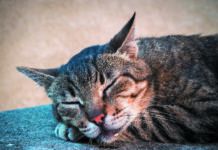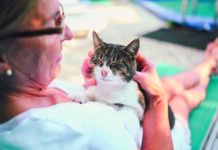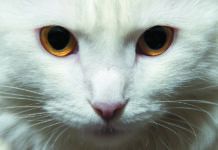[From Tufts March 2012 Issue]
The eyes of cats and dogs are quite similar to our own, but there are notable differences. Feline eyes were designed with the night hunter in mind, one reason that cats have the largest eyes of any meat eater. If our own eyes were proportionally the same, human eyes would be eight inches across.
The difference between cat and dog eyes goes beyond size. The way pets see influences how they interact with each other — and with us.
“Placement of the eyes in the skull affects the animals’ ability to see, as it affects their binocular field of view versus monocular field of view,” says Christopher Pirie, DVM, veterinary ophthalmologist and Assistant Professor at Cummings School of Veterinary Medicine at Tufts University. “Globes that are placed closer together provide a greater degree of visual overlap as well as better binocular vision and depth perception than globes placed farther apart.
Eye locations vary between predators and prey
Predators like dogs and cats have eyes toward the front of the face while prey animals like mice and deer have eyes on each side of the head so that they can watch in two directions at once.
Dog eye placement varies slightly among breeds. Flat-faced pugs, for example, have more forward eye placement and greater binocular vision than long-nosed breeds such as greyhounds. On average, though, dogs have about 30 to 60 degrees of binocular overlap. Cats have about 130 degrees binocular vision compared to 120 degrees in people.
But dogs are champions when it comes to visual field of view. That means when a dog looks straight ahead, he can see 240 degrees, compared to 200 degrees in cats and 180 degrees in humans.
“Most dogs and cats are emmetropic — normal sighted,” explains Dr. Pirie. “The reported average acuity of canines is 20/75 and cats 20/100.”
But both dogs and cats rely more on motion rather than focus. In fact, dogs tend to be better at distance vision when, for instance, scanning the horizon for herds of deer. A dog can detect strong hand signals from as far away as one mile.
Can cats see in the dark? How about dogs? It certainly appears that they both see in low light better than people do for a couple of reasons.
Iris regulates the amount of light
The colored portion of the cat and dog eye is a highly specialized muscle called the iris. The iris opens and closes to regulate the amount of light that enters the eye through the pupil. The dog’s iris is like ours, and can contract to a tiny round shape or open wide in low light.
But the cat’s iris is a more complex figure-eight muscle. It opens to a round shape like the dog’s, but can close to a slit that shuts out even more light than can the canine eye.
“The shape of the iris of the cat is believed to assist in minimizing certain aberrations of the lens, and combined with a multifocal lens, improves their vision,” says Dr. Pirie. “Squinting helps the cat focus even better.”
Both cats and dogs have a tapetum lucidum, a layer of highly reflective cells behind the retina that reflects back any light entering the eye and produces that eerie night-shine eye glow. Cats only need only 1/6th the illumination level and use twice as much available light as people. Dogs’ eyes are about half as efficient as cats’ eyes, but are still better at using light than the human eye. In part, that’s because they have a higher rod-to-cone ratio than people do.
“The rods are more sensitive to changes in light and useful for motion detection, but do not allow pets to see well,” says Dr. Pirie. “The cones are primarily responsible for the animals’ visual acuity and are not functioning at such a low level of light — they are not as sensitive as rods are.”
Dog and cat eyes are more sensitive under low light conditions and have a better ability to perceive changes in motion than the human eye, but their visual acuity is poor in low light.
Cats see shades of blue, green and yellow
So do pets see in color? Cats and dogs possess fewer specialized cone cells that distinguish color than people do. They can see color, but it doesn’t appear to be as important to them. And unlike people who see combinations of red, blue and yellow, cats and dogs appear to have fewer red-detecting cones and so mostly see shades of blue, green and yellow.
Dogs seem to be similar to people who are “red-green color-blind.” Dogs can readily be taught to distinguish between certain colors, but cats take longer to understand why color should matter and most easily can distinguish between colors that contrast. For cats, pattern and brightness are more important than color.
Cats are experts at seeing motion from the corners of their eyes and have about 155-degrees of peripheral vision. Cats also have a highly specialized ability to make extremely rapid eye movements. That allows them to better detect and follow an object, such as a mouse or even a feather on the end of a string toy.
Both cats and dogs have a high density line of vision cells across the retina, called a visual streak. That lets them sharply focus on objects at a distance even in the extremes of peripheral vision — out of the corners of their eyes.
“It is believed this extension of cones improves the animals’ ability to see — particularly along the horizon — and serves as an adaptation based on the evolutionary requirement of the animal,” says Dr. Pirie.
Cats and dogs often seem to ignore stationary objects because if an object doesn’t move, it may not be noticed by the pet. That’s probably why mice instinctively freeze in the presence of a cat. But the visual streak triggers their instinctive urge to chase whenever something moves in their peripheral vision.
The visual streak is most pronounced in long-nosed dogs — the breeds developed to hunt and chase. But many of the short-nosed dogs like pugs don’t have a visual streak. Instead, they have high density vision cells arranged in a single spot on the retina, called the area centralis. The area centralis has three times the density of nerve endings as the visual streak. That may make short-nose dogs and perhaps some cats better able to see and react to human facial expressions — or watch television.



